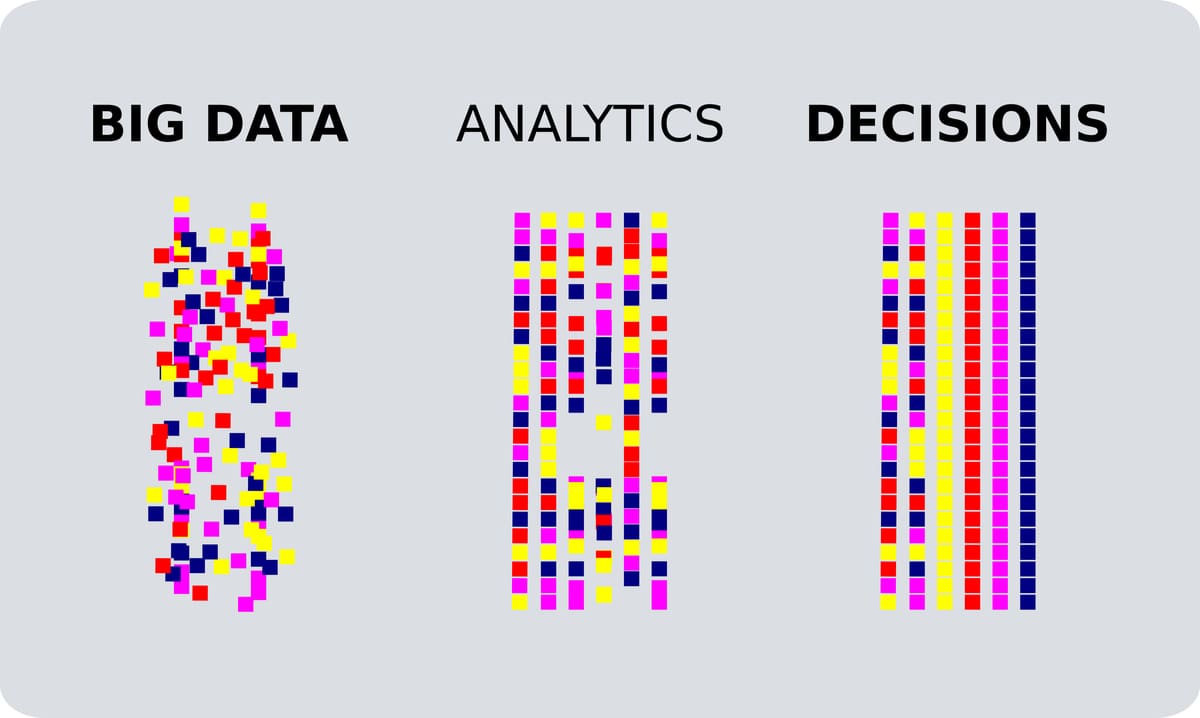“Without data, you’re just another person with an opinion,” says W. Edwards Deming, a statistician, and author. True to these words, when your marketing strategy isn’t data-driven and relies on guesses and assumptions, your business may suffer in this competitive, ever-evolving landscape. A business of any size can utilize a data-driven marketing approach. However, big data marketing analytics is most useful for businesses that produce and work with larger sets of data.
When using marketing automation, there is already data stored on your platform, but when big data enters the stage, you must invest in additional services to answer questions critical to your business.

Today’s post is a guide dedicated to big data in marketing, answering the following questions:
- What is big data in marketing?
- Collecting and processing data: how does it work?
- What are the types of big data?
- How is big data used in e-commerce business?
- What are the challenges of big data in marketing?
There are so many misconceptions about what big data is about and how businesses can use it. To clear up the confusion, this guide will dissect the topic from a professional viewpoint while keeping it simple.
What is Big Data in Marketing?
Before diving into the role of big data in marketing, let’s answer the most basic question: what is big data anyway?
The Cambridge Dictionary defines big data as “very large sets of data that are produced by people using the internet, and that can only be stored, understood, and used with the help of special tools and methods.”

According to Gartner, big data is “data that contains greater variety arriving in increasing volumes and with ever-higher velocity”.
Many sources explain big data using models like the 3v’s or the 5 v’s. However, we can really only call data big if it’s impossible to process on one machine. By “process,” we mean to collect, clean, and analyze data, build AI solutions, etc.
Collecting and processing big data has tons of benefits for marketing teams, including the ability to:
- capture small but important patterns
- better understand customers and prospects
- optimize strategies and campaigns
- make informed marketing decisions
- build personalized and long-lasting relations with your audience
Now that we’ve defined big data and examined data-driven marketing benefits, let’s look at how it works to understand what tools are required to reap those benefits.
Collecting and Processing Big Data: How Does It Work?
For most businesses, building and maintaining data storage from scratch will be extremely time-consuming and costly. That is why it is better to use a third-party service, or cloud provider, that will store data securely and require a relatively small monthly investment.
To analyze data, you’ll need software that will be able to process millions of pieces of data. E-commerce businesses, for example, may generate thousands of transactions every hour that humans can’t analyze entirely manually.

An e-commerce store might want to know at which hour most purchases happen, which products (or product color or size) are in the highest demand, which channels purchases come from, etc. Questions you may want the answers to are endless and dependent on your business goals. Another kind of software you might use is data visualization, which turns raw data into plots and figures teams can use to improve their decision-making process. If we are talking about a large company, that wants to take its data analysis to the next level, a solution would be to invest in business intelligence automation tools.
What Are the Types of Big Data?
Big data can be categorized as either structured, semi-structured, or unstructured. However, regarding types of big data as either structured or unstructured is a more accurate approach.
Structured Data
Structured is the easiest type of data to work with. It tells a direct story and requires little to no effort to process.
For example, you might be analyzing data on your lead distribution platform, in which case you already have the leads in your system and parameters assigned to each lead generated, e.g., location, age, annual company revenue, and position.
When you introduce data in a structured way, it may look something like this:
| Lead | Location | Age | Company annual income | Position |
| Lead 1 | USA | 35-45 | $250,000-500,000 | CTO |
| Lead 2 | Canada | 25-35 | $500,000-1,000,000 | Deputy CTO |
| Lead 3 | Australia | 25-35 | $100,000-250,000 | CEO |
As you can see, structured data comes in the form of numbers, symbols, and words. It is not necessary to further translate any piece into more digestible information. You can easily determine whether a lead is relevant to your business, which salesperson it should be assigned to, etc.
Unstructured Data
Unstructured data isn’t organized in a certain order and can be expressed through images, text, audio, or video. You must first order the data to be able to derive insights. Unstructured data requires more time to process and analyze, but the results can be extremely beneficial and informative.
From a marketing perspective, unstructured data is available in numerous forms. Below we list a few of the most popular types:
- Customer reviews, testimonials, and recommendations
- Comments on websites or social media profiles
- Phone/video call transcriptions
- Survey responses
- Email queries
- Information received via form submissions
- User-generated content in the form of photos, stories, videos, and voice messages
- Ad images and copies
There are no limitations to the format in which unstructured data should be.
How is Big Data Used in E-commerce Business?
If we listed every case in which one can apply big data in marketing, this would be an e-book rather than a guide. That’s why, here, we picked one industry – e-commerce – to illuminate the scenarios in which online stores will benefit the most.

Understand Which Products To Sell Online
Data is especially important for online stores with physical warehouses rather than drop shippers. You’ll want to avoid filling your warehouse with products that are out of mode or in low demand, which may cost extraneous expenses and carries the risk of lost or damaged products. Data helps you identify the trendiest products in the last X months and guides you through the product selection process.
Launch New Products With Confidence
When implementing a new product idea, you can’t know with certainty whether it will succeed. You might be unsure how to organize the promotion process and which channels to choose. With the help of big data, you can predict how a new product will perform.
Recommend Products Based on Your Visitor’s Buying And/or Search History
People visiting your online store have different style preferences, tastes, and budgets. Not all product recommendations will be relevant to each buyer. Big data helps you personalize your suggestions, thus increasing the likelihood of a sale. For example, you can use a visitor’s browsing history or products bought or added to the cart to promote similar offers.
Optimize Your Online Store Prices
Many online stores use simple strategies to define the price. One such strategy calculates production cost + 10% profit margin on average. In this competitive economy, traditional strategies aren’t as effective as they once were. With the help of big data, you are able to analyze millions of prices and set the most suitable ones for your products.
Analyze Ads
Online stores often use different mediums to run ads and promote products. However, not all campaigns are equal. Luckily, you can learn from other companies mistakes. In this scenario, big data can help you analyze how certain ads and promotions performed and the level of engagement they drove.
What Are the Challenges of Big Data in Marketing?
Big gains require big investments and overcoming challenges. Some of the challenges of data-driven marketing analytics include but are not limited to:
- Insufficient technology
- Lack of internal experience
- Lack of first-party data
- Difficulty in proving ROI
- Poor data-sharing protocols
- Lack of resources
- Lack of quality third-party data
Below you will find more detailed information on three of the most significant challenges in big data marketing analytics.

Accuracy Of Data
Even as advanced tools designed for collecting and analyzing data enter the market, the problem of data accuracy still persists. In digital marketing, this dilemma is expressed in various ways.
Competitors might visit your landing pages, download your resources, or click your ads for research purposes. This is enough to generate data that is misleading and does not express the views of your ideal and actual customers.
Luckily, there are tools that exist to prevent this kind of fraudulent activity. For example, some software protects your PPC campaigns from click fraud.
Quantity Of Data
There is no strict definition of what size data is considered big data, which makes it difficult to pinpoint the exact amount of data you need for a successful analytics process. Thus, one problem analytics teams face is a lack of quality data.
Consider a scenario in which you are conducting an online survey and want to answer a particular question or set of questions. For an X survey, a sample size of 100 may be enough to come to a conclusion. That conclusion is more likely to work if you are working in a specific niche and targeting very specific buyer personas. If you find yourself dealing with small data, read this post to understand how to do it.
However, for gaining a deep understanding of a broader topic, 100 respondents may be too small a number, creating the possibility that your findings will be incomplete and not an accurate reflection of reality.
In contrast, the amount of data may be too big and thus harder for your system and analytics team to handle. In this case, you could allocate more memory or try to change the data format.
There’s no strict rule on how much data is required for particular research, whether it’s a survey or ads analysis. It all depends on the methodology and subject of your research.

Resources And Knowledge
There exist hundreds of tools and technologies that allow us to work with large sets of data, but with so many options out there, it becomes harder to decide which data storage service or processing framework to choose.
Analyzing big data also requires a sufficient budget and qualified team members. Though many frameworks are open-source and available for free, you can’t go without hiring data analytics professionals and using third-party paid services.
Digital marketers are usually good analysts and know how to track, optimize, and improve. Data scientists with technical backgrounds should be present on your team to substantiate your findings.
You also need to know how to keep your data safe and whether you need to store any part of your data on-premises. Building and maintaining your company’s own infrastructure is expensive. However, if you have harsh security requirements, you might consider storing part of your data on your own infrastructure.

Final Thoughts
Big data can be a game-changer for businesses in terms of multiplying revenue. If applied unprofessionally, it can result in huge spending and no results. For valuable insights and results, choose the right technologies and the right team members for your analytics process, and let the data tell you what to do next.


